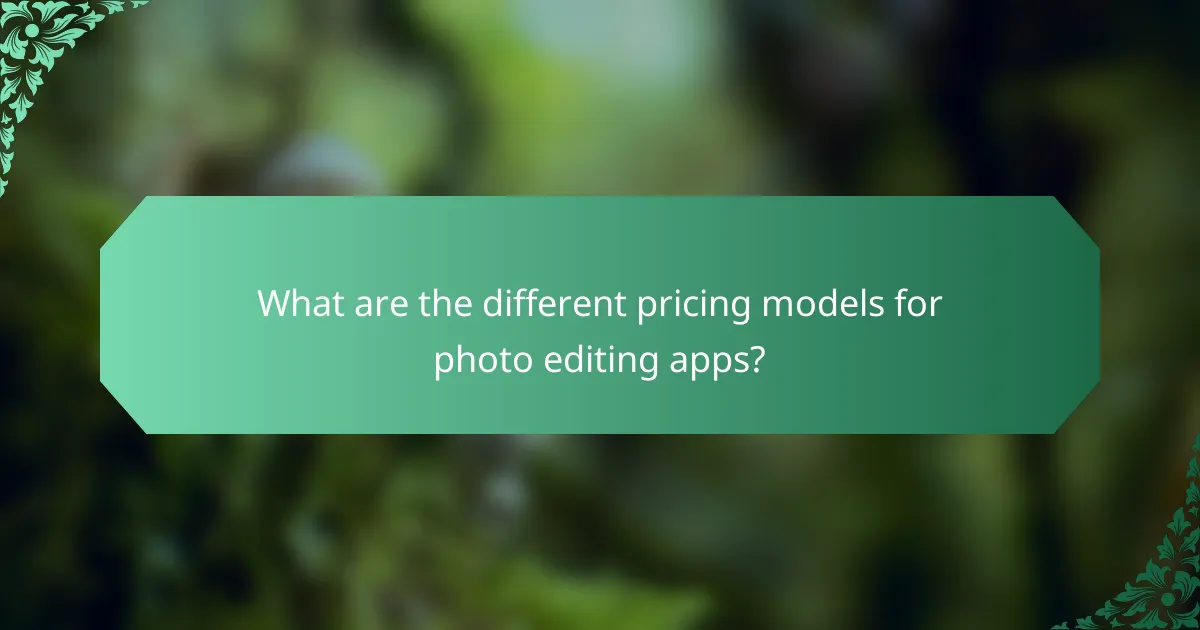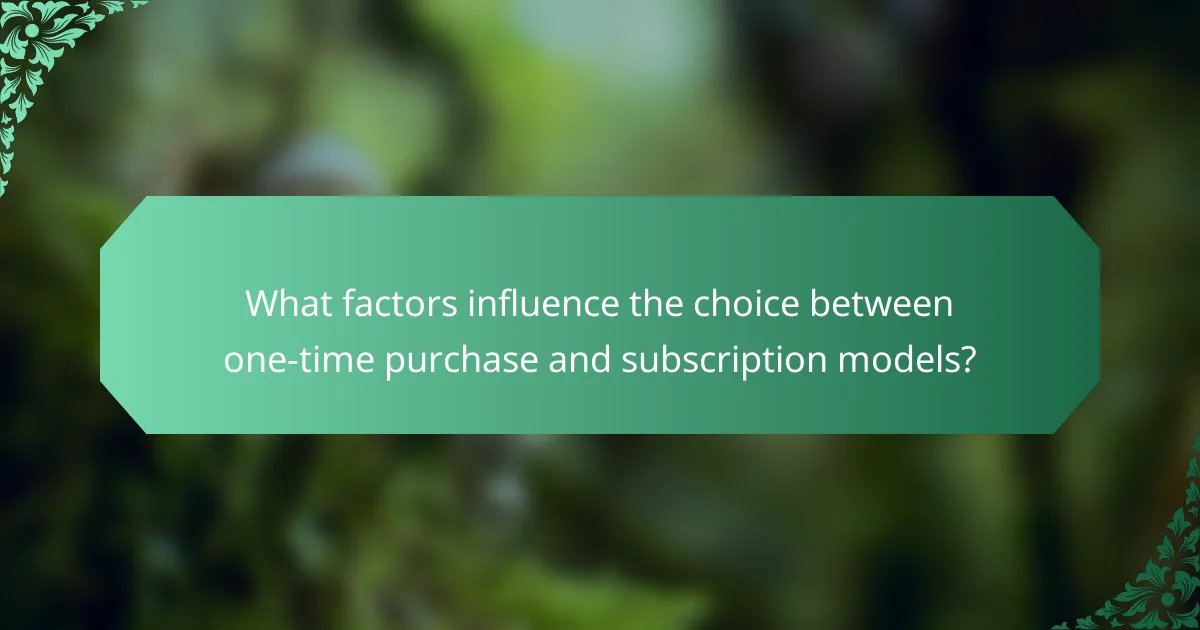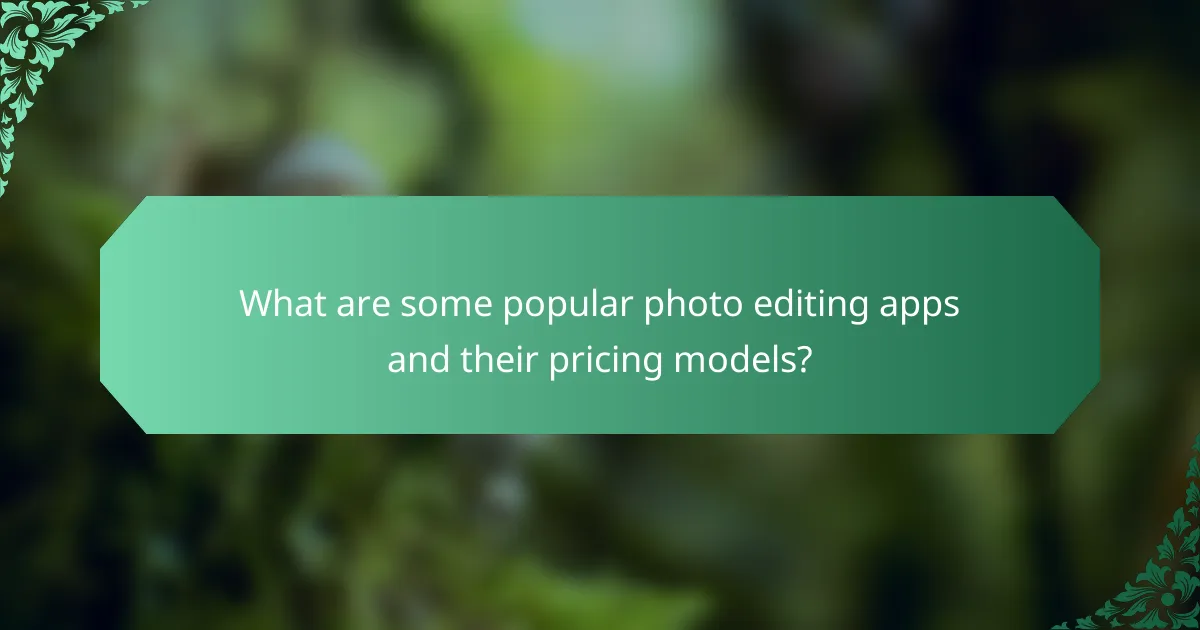The article examines the various pricing models used by popular photo editing apps, focusing on one-time purchase and subscription options. One-time purchase models allow users to pay a single fee for lifetime access, exemplified by Adobe Photoshop Elements and Corel PaintShop Pro. Subscription models, such as Adobe Creative Cloud, charge users on a recurring basis and provide ongoing access to the latest features. Additionally, the article discusses freemium models, which offer basic features for free with optional paid upgrades, and in-app purchases for enhanced functionalities. The analysis highlights how these pricing structures cater to different user preferences and budgets, influencing choices based on cost, usage frequency, and individual needs.

What are the different pricing models for photo editing apps?
Photo editing apps typically use various pricing models. The most common models are one-time purchase and subscription.
One-time purchase allows users to pay a single fee for lifetime access. This model is prevalent in standalone software versions. Examples include Adobe Photoshop Elements and Corel PaintShop Pro.
Subscription models charge users on a recurring basis, often monthly or annually. This model provides access to the latest features and updates. Adobe Creative Cloud is a leading example of this model.
Some apps offer freemium models. Users can access basic features for free but must pay for advanced tools. Examples include Snapseed and Canva.
Finally, some apps may utilize in-app purchases for additional features. This allows users to customize their experience based on their needs.
These pricing models cater to different user preferences and budgets.
How do one-time purchase models work in photo editing apps?
One-time purchase models in photo editing apps require users to pay a single fee for permanent access. Users download the app after the purchase is complete. This model often includes all features available at the time of purchase. Unlike subscription models, there are no recurring fees. Users benefit from one-time purchases as they own the app indefinitely. Updates may be limited or chargeable after the initial purchase. Popular examples include Adobe Photoshop Elements and Affinity Photo. These apps provide a clear cost structure and appeal to users who prefer not to commit to ongoing payments.
What are the advantages of one-time purchases for users?
One-time purchases provide users with full ownership of a product. Users pay a single upfront cost without ongoing fees. This model eliminates subscription fatigue, allowing users to manage expenses better. Users avoid the risk of price increases associated with subscriptions. One-time purchases often include lifetime access to features and updates. Users retain control over their software without recurring commitments. This model can lead to long-term savings compared to continuous subscription payments. Research indicates that 60% of users prefer one-time purchases for their simplicity and transparency.
What are the limitations of one-time purchase models?
One-time purchase models have several limitations. They often lead to higher upfront costs for consumers. This can deter potential buyers who prefer lower initial investments. One-time purchase models typically lack ongoing updates and support. Users may miss out on new features and improvements over time. These models can also limit the developer’s revenue stream. This affects their ability to invest in product development. Additionally, one-time purchases can result in a less engaged user base. Without subscription incentives, users may not feel motivated to use the product regularly. Overall, these limitations can hinder long-term customer satisfaction and product evolution.
How do subscription models function in photo editing apps?
Subscription models in photo editing apps provide users with ongoing access to features for a recurring fee. Users typically pay monthly or annually for these services. This model allows developers to offer regular updates and new features without requiring additional purchases. Subscriptions often include cloud storage, premium tools, and exclusive content. Users benefit from having the latest tools and features without large upfront costs. Many apps offer free trials to attract users. This encourages potential subscribers to experience the app before committing financially. The subscription model has become popular due to its flexibility and continuous improvement of user experience.
What benefits do subscription models offer to users?
Subscription models offer users flexibility and access to a wide range of features. They typically provide continuous updates and improvements, ensuring users have the latest tools. Users benefit from lower upfront costs compared to one-time purchases. This model often includes customer support, which enhances user experience. Additionally, subscriptions may offer trial periods, allowing users to evaluate the service before committing. According to a report by Statista, 70% of consumers prefer subscription services for their convenience and value. These benefits make subscription models appealing for photo editing app users.
What challenges do users face with subscription pricing?
Users face several challenges with subscription pricing. One major challenge is the ongoing cost. Many users prefer a one-time payment to avoid recurring charges. Subscription models can lead to financial strain over time. Another challenge is the perceived value. Users may question whether the benefits justify the monthly fee. Additionally, users may experience subscription fatigue. This occurs when they subscribe to multiple services and struggle to manage them. There is also the issue of cancellation. Some users find it difficult to cancel subscriptions, leading to unwanted charges. Finally, users may face price increases. Companies can raise subscription fees, creating dissatisfaction among loyal customers.

What factors influence the choice between one-time purchase and subscription models?
The choice between one-time purchase and subscription models is influenced by cost, usage frequency, and user preferences. Cost plays a significant role; users may prefer a one-time purchase for a lower initial expense. Subscription models often appeal to those who want access to ongoing updates and features. Usage frequency affects decisions; casual users may favor one-time purchases, while frequent users might find subscriptions more economical over time. User preferences, such as the desire for flexibility or commitment, also impact the choice. According to a survey by Statista, 50% of users prefer subscription models for access to continuous improvements and support.
How does user preference shape pricing model decisions?
User preference significantly influences pricing model decisions in photo editing apps. Users may prefer one-time purchases for cost certainty and ownership. This preference can lead developers to adopt a one-time payment model. Conversely, users favor subscriptions for access to continuous updates and features. This inclination encourages developers to offer subscription-based pricing. Research shows that 70% of consumers prefer subscription services for software due to perceived value. Therefore, understanding user preferences is crucial for pricing strategy development in this market.
What demographic factors impact user preferences for pricing models?
User preferences for pricing models are influenced by demographic factors such as age, income, and education level. Younger users often prefer subscription models due to lower upfront costs. In contrast, older users may favor one-time purchases for perceived long-term value. Income levels also play a significant role; higher-income individuals may opt for subscriptions for convenience and access to premium features. Education level affects awareness and understanding of pricing structures, impacting user choices. Research indicates that these demographic factors significantly shape consumer behavior in software purchasing decisions.
How do usage patterns affect the choice between models?
Usage patterns significantly influence the choice between one-time purchase and subscription models in photo editing apps. Frequent users often prefer subscription models. Subscriptions provide ongoing access to updates and new features, which align with their usage frequency. Infrequent users typically opt for one-time purchase models. This choice minimizes costs while still granting access to essential features. Research indicates that 70% of users who edit photos weekly prefer subscriptions for continuous enhancements. Conversely, users who edit occasionally find one-time purchases more economical. Thus, understanding user engagement levels is crucial for selecting the appropriate pricing model.
What role does software functionality play in pricing model selection?
Software functionality significantly influences pricing model selection. High-functionality software often justifies subscription models due to ongoing updates and support. For example, Adobe Creative Cloud offers extensive features and regular enhancements, making a subscription appealing. Conversely, basic software with limited functionality may be better suited for one-time purchases. Users may prefer to pay once for simple tools without ongoing costs. Market trends show that software with advanced capabilities tends to adopt subscription pricing. This aligns with consumer expectations for continuous improvement and service. Thus, software functionality directly impacts whether a one-time purchase or subscription model is chosen.
How do feature sets differ between one-time purchase and subscription apps?
Feature sets in one-time purchase apps typically offer a complete set of features upon payment. Users gain immediate access to all functionalities without ongoing fees. In contrast, subscription apps often provide a limited feature set initially. They usually expand features over time through updates. Subscription models incentivize continuous development and support. This approach can lead to more frequent enhancements and new tools. For example, Adobe Photoshop’s subscription model includes regular updates and cloud features. One-time purchase apps may lack this dynamic growth, as they rely on users buying new versions for updates.
What additional services might sway users towards subscriptions?
Additional services that might sway users towards subscriptions include cloud storage, premium support, and exclusive content. Cloud storage allows users to save and access their projects from any device. Premium support offers quicker response times and personalized assistance. Exclusive content may include advanced editing tools and filters not available in one-time purchases. Research indicates that 70% of users prefer subscription models for these added conveniences. These services enhance user experience and provide ongoing value, making subscriptions more attractive.

What are some popular photo editing apps and their pricing models?
Popular photo editing apps include Adobe Photoshop, Lightroom, Snapseed, and Canva. Adobe Photoshop operates on a subscription model, costing approximately $20.99 per month. Lightroom also follows a subscription model at around $9.99 per month. Snapseed is completely free, offering no costs for its services. Canva provides both free and subscription options, with the Pro version costing around $12.99 per month. Each app has distinct pricing models that cater to different user needs and preferences.
Which photo editing apps offer one-time purchase options?
Adobe Photoshop Elements offers a one-time purchase option. Affinity Photo is another app that provides a one-time payment model. Corel PaintShop Pro also allows users to buy the software outright. These apps are popular for users who prefer not to subscribe. They provide essential photo editing features without ongoing costs. Each app has distinct functionalities that cater to different editing needs.
What are the price ranges for these one-time purchase apps?
One-time purchase apps typically range from $5 to $100. The price varies based on the app’s features and capabilities. Basic photo editing apps often cost around $10 to $30. More advanced apps with extensive features can reach up to $100. For example, popular apps like Affinity Photo are priced at $49.99. In contrast, apps with limited functionalities might be available for as low as $5.
How do users rate these apps compared to subscription models?
Users generally rate one-time purchase apps more favorably than subscription models. Many users prefer the upfront cost of one-time purchases. This model offers full ownership without ongoing fees. In contrast, subscription models can lead to frustration over recurring payments. A survey indicated that 60% of users favor one-time purchases for their simplicity. Users also appreciate having access to all features without limitations. Subscription models often restrict features based on payment tiers. This can lead to dissatisfaction among users who feel pressured to upgrade. Overall, the preference leans towards one-time purchases due to perceived value and ownership.
Which photo editing apps operate on subscription pricing?
Adobe Photoshop operates on subscription pricing. It is part of Adobe’s Creative Cloud suite. Users pay a monthly fee for access. Another app is Lightroom, also from Adobe, which follows a similar subscription model. Affinity Photo offers a one-time purchase but has subscription options for additional services. Capture One is another subscription-based photo editing app. These apps provide continuous updates and cloud storage as part of their subscription plans.
What are the typical subscription fees for these apps?
Typical subscription fees for popular photo editing apps range from $5 to $30 per month. For example, Adobe Photoshop charges approximately $20.99 monthly for its subscription. Another app, Lightroom, has a subscription fee of about $9.99 per month. Some apps offer annual plans that can reduce the monthly cost. For instance, Adobe Creative Cloud offers an annual subscription at a discounted rate of around $52.99 per month when billed annually. These pricing structures reflect the trend towards subscription models in the photo editing software market.
What unique features do these subscription apps provide?
Subscription apps for photo editing provide unique features such as cloud storage, which allows users to access their projects from multiple devices. They often include regular updates, ensuring users have the latest tools and features without additional costs. Many subscription services offer advanced AI tools for automated editing, enhancing user efficiency. Additionally, these apps frequently provide access to exclusive content, such as premium filters and templates, which are not available in one-time purchase models. User support is typically more robust in subscription models, often featuring live chat and priority assistance. These features collectively enhance user experience and provide ongoing value.
What tips can users follow when choosing between pricing models for photo editing apps?
Users should consider their usage frequency when choosing between pricing models for photo editing apps. Occasional users may benefit from a one-time purchase. This model provides full access without ongoing costs. Frequent users might find subscriptions more economical. Subscriptions often include regular updates and new features. Users should also evaluate the total cost over time. For example, a subscription may seem cheaper initially but can add up. Additionally, users should assess the features offered in each model. Some apps provide premium tools only in subscription plans. Finally, users should read reviews to understand the value of each pricing model. Reviews often highlight user experiences with both options.
The main entity of this article is the pricing models of popular photo editing apps, focusing on the comparison between one-time purchase and subscription models. It outlines the characteristics, advantages, and limitations of each pricing model, highlighting user preferences and demographic influences on these choices. Key examples of photo editing apps, their pricing structures, and unique features are provided to illustrate the differences between the models. Additionally, the article discusses factors affecting user decisions, such as usage patterns and software functionality, guiding users on how to choose the most suitable pricing model for their needs.


